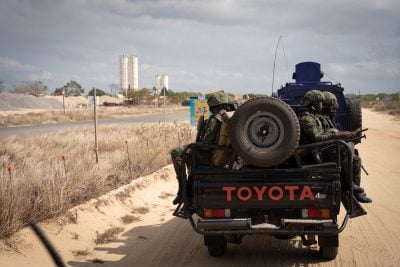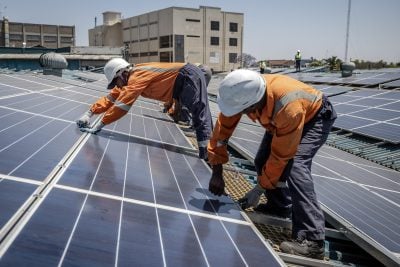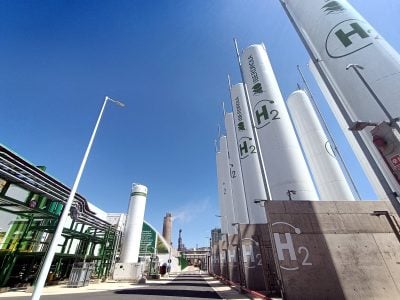In the centre of Côte d’Ivoire’s capital city, Yamoussoukro, a few metres away from the Basilica of Our Lady of Peace – one of the largest churches in the world – a $40m electricity dispatching centre recently opened its doors.
As the second in the country – the first one was built in 1981 in the economic capital Abidjan – the authorities hope it will relaunch economic activities in a city still biding its time. Since the death of Côte d’Ivoire’s first president, Félix Houphouët-Boigny, who made his birthplace the country’s capital, the city’s economic development has been largely neglected.
“In terms of benefits for the city, the new dispatching centre will contribute to the gradual transfer of economic and administrative activities to the capital,” says Noumory Sidibé, CEO of CI-Énergies, the state-owned company which manages the country’s energy production.
The six-acre site, including a control centre and housing for workers, is part of the ENERGOS project, a support programme for the energy sector in Côte d’Ivoire signed in December 2015 with the European Union.
Apart from the dispatching centre, the initial EU loan of $118m is being used to rehabilitate and extend energy networks in the cities of Bouaké, San Pedro and Abidjan, where works are ongoing.
Electricity success story
Twenty-four hours a day, seven days a week, engineers track the operation of the national electricity grid and carry out remote-controlled interventions. Since 2011, the date on which the state-owned company CI-Énergies was created, the country’s energy sector has experienced stunning improvements. Total installed capacity had risen to 2,269 MW by 2021, a 60% increase on 2011.
Average outage time (AOT) decreased from 47 hours in 2011 to about 16 hours in 2020, while the overall electricity access rate went from 55.8% in 2011 to almost 70% in 2020, with the number of electrified localities increasing from 2,847 to 6,781 over the same period.
At 69.7%, the country has one of the highest electricity access rates in West Africa, ahead of neighbours Liberia (27.5%) and Guinea (44.7%), but behind Ghana (86%).
According to the World Bank, Côte d’Ivoire’s electricity success story is due to its progressive openness to public-private partnerships (PPPs).
In the 1990s, the government decided to open up the energy market to the private sector to avoid a recurrence of the major load-shedding crisis of the years before. As a result, PPP investment in the energy sector went from $5.5m in 2011 to more than $810m in 2020.
This strategy led to the creation of major power plants, such as Azito, located at the outskirt of Abidjan and powered by Globeleq, a consortium between British International Investment (70%) and the Norwegian fund Norfund (30%).
Regional ambition
Yamoussoukro’s new dispatching centre not only provides the inhabitants of the capital with reliable electricity supply, but also serves the country’s wider economic ambitions.
Although the country’s energy production largely covers demand – national demand for electricity is 10,020 GWh while total gross national production is 11,210 GWh – the government is still initiating projects for the construction of hydroelectric dams, as well as thermal, biomass and solar power plants.
“For the Ivorian electricity sector, the challenge was to design an infrastructure development plan which meets the strong growth in national demand for electricity as well as Côte d’Ivoire’s export ambitions to neighbouring countries through the reinforcement of the interconnection networks,” says Sidibé.
In particular, the government wishes to stabilise the country’s exports of electricity to the region as they have been particularly volatile in the past 20 years.
Côte d’Ivoire’s electricity exports went from 316 GWh in 1995 to 1238 GWh in 2000, with Ghana accounting for 75%. They then dropped to 415 GWh in 2010, with Burkina Faso and Mali slowly replacing Ghana as main partners.
Exports rebounded in 2020, to reach an all-time high of 1275 GWh, with Mali and Burkina Faso accounting for 750 GWh and 500 GWh respectively.
The government’s strategy is to double exports to 2415 GWh by 2030, notably by shifting westwards towards Liberia, Guinea, and Sierra Leone, through implementation of the Côte d’Ivoire, Liberia, Sierra Leone and Guinea (CLSG) Electricity Networks Interconnection Project.
Initiated in 2013, 1357km of high-voltage lines will target 24m people across the four countries and contribute to the development of an electricity market within the region. Electricity trading in West Africa accounted for only 5% of the gross demand in 2017, while countries like Togo, Benin and Niger are still largely dependent on imports to meet demand.
The extensive project is financed by the European Investment Bank, the African Development Bank, the World Bank and German development bank KfW, alongside the countries involved.
Côte d’Ivoire’s ambition to be a leading electricity exporter within the region matches its status as a top performer among Ecowas countries on the Africa Regional Integration Index, compiled by the African Union, UNECA and the AfDB.
Côte d’Ivoire comes first on the regional integration index in Ecowas while representing only 6% of regional GDP, and sixth after five Southern African countries (Eswatini, Namibia, Lesotho, South Africa, Zimbabwe) for trade integration on the continental as a whole, ranking higher than Kenya, Nigeria, and Ghana.
The CLSG project is projected to be completed by the end of 2023, according to the AfDB. Sidibé recently welcomed a delegation from Sierra Leone to sign a purchase contract, having visited Liberia and Guinea last year.
Contracts are based on a Take or Pay system – obligating the buyer to either buy and take delivery of a minimum quantity of power or to pay the seller for any shortfall - with a duration of three years, renewable by agreement between the parties from the second year onwards.
Côte d'Ivoire’s role as a primary source of electricity for its neighbours nevertheless brings renewed geopolitical scrutiny. In late September, an official from the Compagnie Ivorienne d'Electricité denied that power cuts in Bamako and other cities across Mali were a response to the July arrest and continued detention of 49 Ivorian soldiers at Bamako Airport.
The official blamed the blackouts on repair works on the line. But if geopolitical tensions can be ironed out, the project will offer a substantial boost to the region’s long inadequate energy capacity.
Want to continue reading? Subscribe today.
You've read all your free articles for this month! Subscribe now to enjoy full access to our content.
Digital Monthly
£8.00 / month
Receive full unlimited access to our articles, opinions, podcasts and more.
Digital Yearly
£70.00 / year
Our best value offer - save £26 and gain access to all of our digital content for an entire year!
 Sign in with Google
Sign in with Google 



